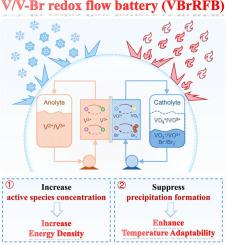One Stone Two Birds: Enhancing Energy Density and Temperature Adaptability for Vanadium-based Redox Flow Batteries via Dual Active Species Strategy
IF 20.2
1区 材料科学
Q1 CHEMISTRY, PHYSICAL
引用次数: 0
Abstract
Vanadium-based redox flow batteries, characterized by no cross-contamination issue, are considered as one of the most promising candidates for large-scale energy storage. However, due to vanadium ions show relatively low solubility and are easy to precipitate at extreme temperatures, the battery suffers from the long challenge of low energy density and poor temperature adaptability. In this work, by introducing vanadium and bromine dual active species into the positive electrolyte, a novel V/V-Br redox flow battery (VBrRFB) is developed to boost the energy density and temperature window of vanadium-based flow batteries. The bromine, not only acts as the secondary redox couple to enhance the overall concentration of active species, but also disrupts the hydrogen bond network while optimizing the solvation structure of vanadium. As a result, the VBrRFB achieves an energy density of as high as 152.4 Wh L-1catholyte (38.1 Wh L-1catholyte+anolyte), which is 265.9% higher than traditional all-vanadium redox flow batteries, while maintaining stable cycling over 250 cycles with an energy efficiency of 82.5%. Additionally, the VBrRFB exhibited excellent stability and performance from -10°C to 50°C, with energy densities of 107.6 Wh L-1catholyte at 50 °C and 88.8 Wh L-1catholyte at -10 °C, demonstrating its strong potential for practical energy storage.

一石两鸟:通过双活性物种策略提高钒基氧化还原液流电池的能量密度和温度适应性
钒基氧化还原液流电池具有无交叉污染的特点,被认为是大规模储能最有前途的候选者之一。然而,由于钒离子溶解度较低,在极端温度下容易析出,电池长期面临能量密度低、温度适应性差的挑战。本文通过在正电解质中引入钒和溴双活性物质,研制了一种新型V/V- br氧化还原液流电池(VBrRFB),以提高钒基液流电池的能量密度和温度窗。溴不仅作为二级氧化还原偶体,提高活性物质的整体浓度,还破坏了氢键网络,优化了钒的溶剂化结构。结果,VBrRFB实现了高达152.4 Wh l- 1阴极电解质(38.1 Wh l- 1阴极电解质+阳极电解质)的能量密度,比传统的全钒氧化还原液流电池高出265.9%,同时保持250次循环的稳定循环,能量效率为82.5%。此外,VBrRFB在-10°C至50°C期间表现出优异的稳定性和性能,在50°C和-10°C时的能量密度分别为107.6 Wh和88.8 Wh,显示出其在实际储能方面的强大潜力。
本文章由计算机程序翻译,如有差异,请以英文原文为准。
求助全文
约1分钟内获得全文
求助全文
来源期刊

Energy Storage Materials
Materials Science-General Materials Science
CiteScore
33.00
自引率
5.90%
发文量
652
审稿时长
27 days
期刊介绍:
Energy Storage Materials is a global interdisciplinary journal dedicated to sharing scientific and technological advancements in materials and devices for advanced energy storage and related energy conversion, such as in metal-O2 batteries. The journal features comprehensive research articles, including full papers and short communications, as well as authoritative feature articles and reviews by leading experts in the field.
Energy Storage Materials covers a wide range of topics, including the synthesis, fabrication, structure, properties, performance, and technological applications of energy storage materials. Additionally, the journal explores strategies, policies, and developments in the field of energy storage materials and devices for sustainable energy.
Published papers are selected based on their scientific and technological significance, their ability to provide valuable new knowledge, and their relevance to the international research community.
 求助内容:
求助内容: 应助结果提醒方式:
应助结果提醒方式:


